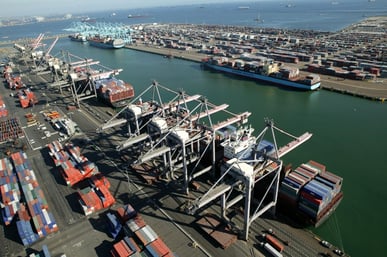September 6, 2016 - Oslo, Norway - Xeneta, the leading global benchmarking and market intelligence platform for containerized ocean freight, believes the container ship sector remains mired in troubled waters, despite a recent rate rise on key east-west trades. This positive swing, it says, belies an industry still suffering from weak demand, increased void sailings and devastated profit margins.
Xeneta crowd-sources data from more than 600 major international businesses, providing real-time information across over 12 million contracted rates, covering more than 60,000 port-to-port pairings. This gives the Oslo-based business a unique insight into a sector where the only constant appears to be constant change.
“The container ship sector has been in a state of flux for some time,” comments Xeneta CEO Patrik Berglund, “and, unfortunately for its key players, the prospect of stability remains a distant speck on the horizon.
“Short term rates have been rising on the main Far East Asian to North European port route, the world’s most important trade channel, since hitting lows in March. At that point the market average price for a 40’ container stood at USD 552, now it’s climbed to USD 1172. On the face of it, this is a strong development for container ship companies, but the industry has been undermined by weak fundamentals for so long that it’s not quite that simple.”
Berglund points to structural problems within the segment, with 2016 beginning with severe overcapacity. In the last calendar year some 208 newbuilds were introduced to a market already awash with a new breed of megaships, leading to an 8.1% oversupply of TEUs. This, he opines, has effectively hamstrung businesses:
“There’s simply been too much space and not enough demand,” Berglund says. “European economies remain fragile, US inventory levels are high and Chinese imports have receded as a result. The industry is trying to respond, with mergers, acquisitions and an increased number of void sailings, but is that enough to fix the underlying problems in the near future? I’d argue that it’s not.”
The Xeneta CEO points to the difficulties that even giant players are facing, with Moller-Maersk recently announcing a 90% fall in year-on-year net profit for Q2 2016. April to June figures saw the result stand at USD 101 million, short of the forecast USD 196 million and way below the previous year’s USD 1.069 billion.
“Carriers have still managed to lock in customers with long-term contracts, but at much reduced levels,” Berglund states, “The market was so tough that they’ve been forced to accept such rates - the alternative is not moving the cargo. This has damaged revenues.”
“However, there is an adjustment as the market slowly trends upwards. Our feedback from shippers shows that they’re now struggling to negotiate market average prices from suppliers. This provides a strong indication that the upwards rate trend will continue and that container ship operators don’t want to get locked in to long-term contracts at the same low levels they’ve previously offered. “
Berglund believes the news of Hanjin’s bankruptcy adds yet another twist to the unpredictable container segment storyline.
“Competitors will now be battling for market share and scrambling to fill the holes created by the firm’s demise,” he suggests. “This should allow them to crank up prices. One additional possibility is an acquisition from one of the larger market players to consolidate market share. Watch this space.”
Berglund says the road to stability could be both long and bumpy. He believes setting prices on an exchange could provide a solution but, in the immediate future, businesses shipping containers need to use available big data to keep on top of on-going market fluctuations.
“Software platforms such as Xeneta, which knows the industry inside out, give shippers, freight forwarders and carriers the data they need to get the right price for their cargoes,” he concludes. “The idea of turning container shipping into a commodity, with fair prices set on an exchange is an interesting and, we believe, viable option. That would give everyone a stable platform to work from.
“Reliable, real-time data like ours could inform such an exchange. In the meantime it’ll help businesses get the ammunition needed to make the right decisions and stay abreast of this most dynamic of shipping sectors.”


-1.jpg)

